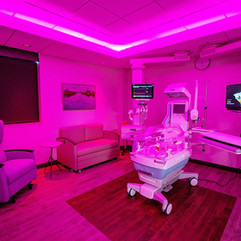A Rhythmic NICU - Using the Color of Light to Aid Circadian Development
By J. Douglas McCurry, Jr. AIA, NCARB, SAR
Partner | Principal - TRO | Jung Brannen

We have all heard the saying that “time cures all”, but time also makes some things that were once not possible…possible. Over twenty years ago while designing another NICU, I wanted to incorporate the ability for the staff to not only change the cyclical lighting levels, but also the color of lighting to potentially influence the development of circadian rhythms in preterm infants by imitating the colors of light we see throughout Creation every day. Due to the lighting technology available at that time, we were left only with the ability to adjust the light levels by dimmers and choose the temperature or kelvin, of the light. Although colored lights of one type or another were available at the time, neither were adjustable or appropriate to the application. Time and technology made it possible for lighting development to give us LED’s that are both color adjustable and dimmable.
Premature babies are sensitive to light. Prior to studies on the influence of light in NICU environments, high light intensity was standard not only in general hospital treatment areas and patient rooms but also in neonatal intensive care units, with the most precious and vulnerable patients being exposed to continuous bright lights. Technical research and studies of circadian development recommended low intensity cycled lighting in the neonatal nursery and resulted in preterm infants having a greater rate of weight gain, less crying, less time on ventilators, and enhanced motor coordination. Through these studies starting in the early ’80s, neonatal physicians and nurses know preterm infants need a controlled lighting environment that benefits their development and growth. The importance of low intensity cycled light regulation to the circadian system development in premature infants has become an important part of neonatal care and not only aids the sleep-wake cycle but creates patterns that are in phase with the 24-hour light-dark cycle.

Recent research has shown that in the light spectrum, blue light in a wavelength of 438 to 493 nanometers is what controls our circadian rhythm. Other short wave light colors on either side of the blue spectrum, violet and green, also affect our circadian clock but start losing their influence within the first hour of awaking and continue to diminish through the day. Longer wavelengths of red, yellow, and orange light are not seen by the circadian clock. Circadian blue light is the color of the clear blue sky and is the only color that penetrates the ocean depths. It is the only color that triggers our day-night awareness.
During the design of the new NICU Nursery for East Alabama Health, our goal was to incorporate both indirect and color adjusting lighting in the infant care rooms. Room lighting that can be color adjusted to reflect the time of day will potentially aid preterm infants in the development of their circadian rhythm and provide visual stimuli to aid in retinal development and melatonin production. Since infant feeding times occur all day, we wanted to re-create the corresponding natural light occurring outside instead of only having white light as the only available source. We utilized LED CovePerfekt luminaires by Axis Lighting with Axitune technology that have tunable white and color tuning capabilities. Recessed in light coves that surround the entire room, the nursing staff can choose dimmable white lighting from 1650K to 8000K, blue, purple, red, lime, or orange from a wall-mounted electronic control panel. Normal lighting standards were provided in other areas to not impair the ability of the staff to carry out their work. Light control from the corridor to the private infant rooms is control by integrated Unicel blinds provided in the ICU door glazing that is fully adjustable to provide visual control and privacy.

Owner: East Alabama Health, Opelika, Alabama
Architect: TRO | Jung Brannen
Principal / Designer: J. Douglas McCurry, Jr. AIA, NCARB
Project Architect: John McDaniel
Contractor: Bailey-Harris Construction Company
Project Manager: Scot Wilkes
Superintendent: Jasper Bowdoin
Mechanical / Plumbing: Bernhard
Patrick Collins, PE
Electrical: Ray Engineering
David Hoppe, PE























Comments